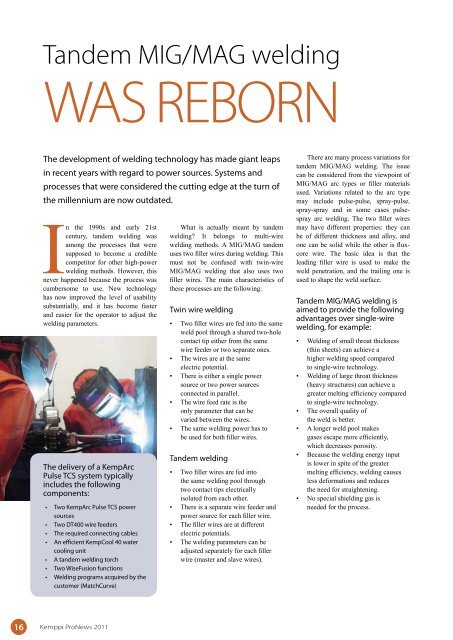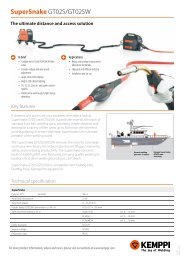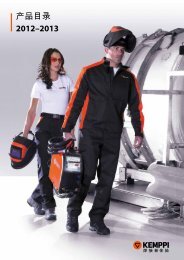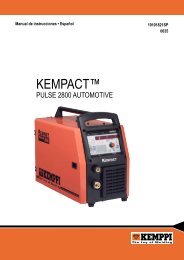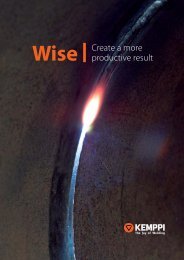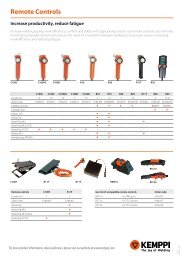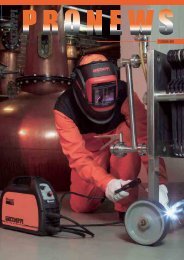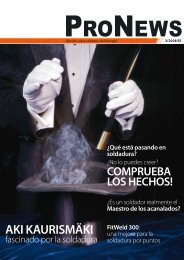Download - Kemppi Connections
Download - Kemppi Connections
Download - Kemppi Connections
You also want an ePaper? Increase the reach of your titles
YUMPU automatically turns print PDFs into web optimized ePapers that Google loves.
Tandem MIG/MAG welding<br />
was reborn<br />
The development of welding technology has made giant leaps<br />
in recent years with regard to power sources. Systems and<br />
processes that were considered the cutting edge at the turn of<br />
the millennium are now outdated.<br />
In the 1990s and early 21st<br />
century, tandem welding was<br />
among the processes that were<br />
supposed to become a credible<br />
competitor for other high-power<br />
welding methods. However, this<br />
never happened because the process was<br />
cumbersome to use. New technology<br />
has now improved the level of usability<br />
substantially, and it has become faster<br />
and easier for the operator to adjust the<br />
welding parameters.<br />
The delivery of a KempArc<br />
Pulse TCS system typically<br />
includes the following<br />
components:<br />
• Two KempArc Pulse TCS power<br />
sources<br />
• Two DT400 wire feeders<br />
• The required connecting cables<br />
• An efficient KempCool 40 water<br />
cooling unit<br />
• A tandem welding torch<br />
• Two WiseFusion functions<br />
• Welding programs acquired by the<br />
customer (MatchCurve)<br />
What is actually meant by tandem<br />
welding It belongs to multi-wire<br />
welding methods. A MIG/MAG tandem<br />
uses two filler wires during welding. This<br />
must not be confused with twin-wire<br />
MIG/MAG welding that also uses two<br />
filler wires. The main characteristics of<br />
these processes are the following:<br />
Twin wire welding<br />
• Two filler wires are fed into the same<br />
weld pool through a shared two-hole<br />
contact tip either from the same<br />
wire feeder or two separate ones.<br />
• The wires are at the same<br />
electric potential.<br />
• There is either a single power<br />
source or two power sources<br />
connected in parallel.<br />
• The wire feed rate is the<br />
only parameter that can be<br />
varied between the wires.<br />
• The same welding power has to<br />
be used for both filler wires.<br />
Tandem welding<br />
• Two filler wires are fed into<br />
the same welding pool through<br />
two contact tips electrically<br />
isolated from each other.<br />
• There is a separate wire feeder and<br />
power source for each filler wire.<br />
• The filler wires are at different<br />
electric potentials.<br />
• The welding parameters can be<br />
adjusted separately for each filler<br />
wire (master and slave wires).<br />
There are many process variations for<br />
tandem MIG/MAG welding. The issue<br />
can be considered from the viewpoint of<br />
MIG/MAG arc types or filler materials<br />
used. Variations related to the arc type<br />
may include pulse-pulse, spray-pulse,<br />
spray-spray and in some cases pulsespray<br />
arc welding. The two filler wires<br />
may have different properties: they can<br />
be of different thickness and alloy, and<br />
one can be solid while the other is fluxcore<br />
wire. The basic idea is that the<br />
leading filler wire is used to make the<br />
weld penetration, and the trailing one is<br />
used to shape the weld surface.<br />
Tandem MIG/MAG welding is<br />
aimed to provide the following<br />
advantages over single-wire<br />
welding, for example:<br />
• Welding of small throat thickness<br />
(thin sheets) can achieve a<br />
higher welding speed compared<br />
to single-wire technology.<br />
• Welding of large throat thickness<br />
(heavy structures) can achieve a<br />
greater melting efficiency compared<br />
to single-wire technology.<br />
• The overall quality of<br />
the weld is better.<br />
• A longer weld pool makes<br />
gases escape more efficiently,<br />
which decreases porosity.<br />
• Because the welding energy input<br />
is lower in spite of the greater<br />
melting efficiency, welding causes<br />
less deformations and reduces<br />
the need for straightening.<br />
• No special shielding gas is<br />
needed for the process.<br />
16 <strong>Kemppi</strong> ProNews 2011


